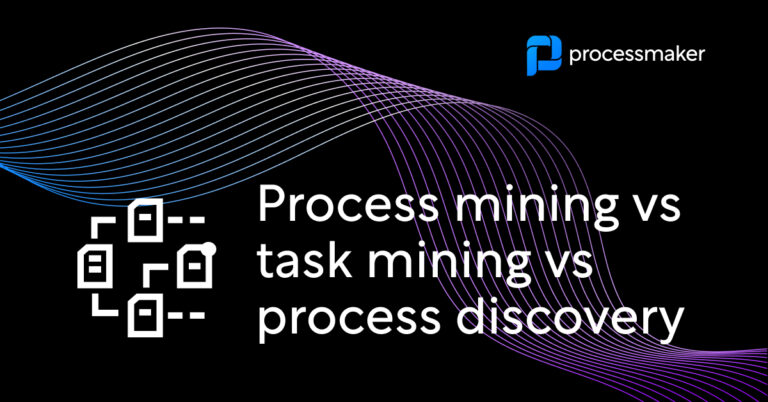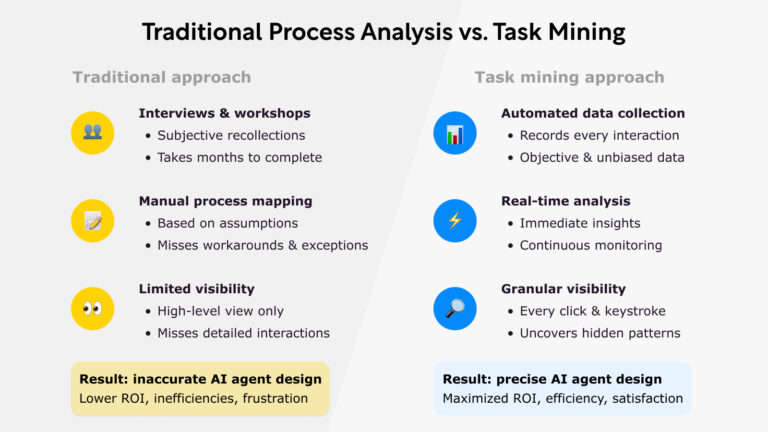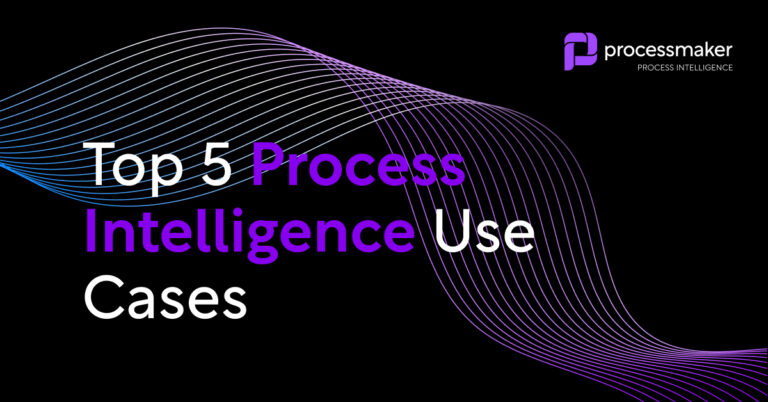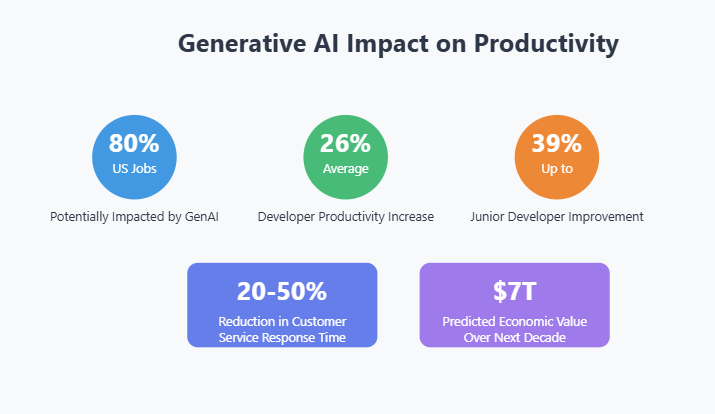As companies embark on digital transformation initiatives, they often encounter the challenge of overwhelming choices. With a myriad of “different” technologies, countless vendors, and numerous consulting firms each presenting their unique perspectives, it can be difficult to navigate the landscape. Compounding this issue is the confusing terminology that pervades the industry.
Today, we aim to clarify the distinctions among three commonly misunderstood terms: process mining, process discovery, and task mining. Our goal is to simplify your understanding of these concepts and provide a clear comparison, including the differences between process mining and task mining.
These three technologies have emerged as essential tools for uncovering business processes, serving as the critical first step in most automation initiatives today. By mapping these processes, they generate valuable insights that significantly aid in decision-making. Equipped with this knowledge, companies can take informed actions, such as implementing Robotic Process Automation (RPA).
So, what exactly are these technologies, what do they share in common, and how do they differ? Let’s dive in to demystify these concepts.
What is process mining?
Process mining is a powerful process mapping tool used for end-to-end process optimization. It uses data from event logs that are available in enterprise systems, and process mining tools can identify inefficiencies and bottlenecks. This approach provides a foundation for process improvement by analyzing and optimizing existing processes. Based on that data, it builds the as-is process and then compares it to the “desired” process that’s also called a happy path. By doing the conformance checking, companies can spot process deviations and find improvement opportunities.
What is process discovery?
Process discovery involves a combination of techniques, such as machine learning and computer vision, to effectively map organizational processes. The insights gained serve as a foundation for automation initiatives. Essentially, process discovery monitors and captures user interactions across various information systems and applications, documenting employees’ digital footprints. By employing diverse computational and statistical methods, process discovery extracts valuable and actionable information from the gathered data.
In comparison, process mining solutions are analytical tools utilized in business process management that leverage system data to provide a comprehensive view of processes. These solutions not only offer insights into process efficiencies and bottlenecks but can also be integrated with task mining for enhanced visibility into both quantitative and qualitative aspects of business processes.
What is task mining?
Task mining is a process mapping tool designed specifically for optimizing tasks on desktops. Similar to process discovery, it tracks the digital footprints of users. By utilizing character recognition, natural language processing, and various analytical tools, it examines user interaction data—such as mouse clicks and keystrokes—to identify patterns that may reveal opportunities for improvement. Task mining solutions complement process mining by providing a detailed view of microelements within business processes, focusing on user interface interactions and workflow activities.
While this may seem confusing initially, a step-by-step comparison will certainly clarify things. Let’s explore the following five criteria.
Process discovery vs task mining?
Feeling overwhelmed by the countless definitions of the same concept is quite common. Different companies often have their own interpretations of specific terms, which adds to the complexity and blurs the distinctions between them.
Let’s clarify the differences between process discovery and task mining, as these terms are frequently used interchangeably. Although both tools leverage similar technologies and aim for comparable outcomes, they serve different purposes. Analyzing the leading service providers reveals a clear trend: process mining companies typically offer task mining as a complementary service, while RPA vendors focus on process discovery.
Both technologies track user desktops to capture interactions with various applications and IT systems. While task mining focuses on identifying process inefficiencies, process discovery leverages this data to uncover automation opportunities more effectively, particularly in optimizing core business processes. Although their functions are closely related, they may yield slightly different outcomes.
We could conclude our discussion on process discovery here, but the terminology surrounding it is too intricate to overlook. In fact, “process discovery” also refers to the initial phase within the broader process mining framework, which includes process discovery, conformance checking, and enhancement.
In a nutshell, process discovery might be used as
- Complementary technology for RPA.
- One of the steps within process mining.
Process mining vs task mining?
Task mining vs process mining often go hand in hand and get used together for knowledge work discovery. While both are pretty powerful, they bring better results and higher work coverage when used simultaneously. To fully understand what each of them does, let’s discuss the differences between process mining and task mining.
As discussed, process mining offers insights into end-to-end processes. A process consists of a logical sequence of individual events with a defined beginning and end. These processes can be broken down into subtasks, creating a cohesive set of related activities. For instance, the Purchase-to-Pay process spans multiple teams.
Conversely, tasks are the smaller work components that occur within and between different processes and subprocesses. Examples of manual tasks include copying and pasting data, as well as uploading and downloading files.
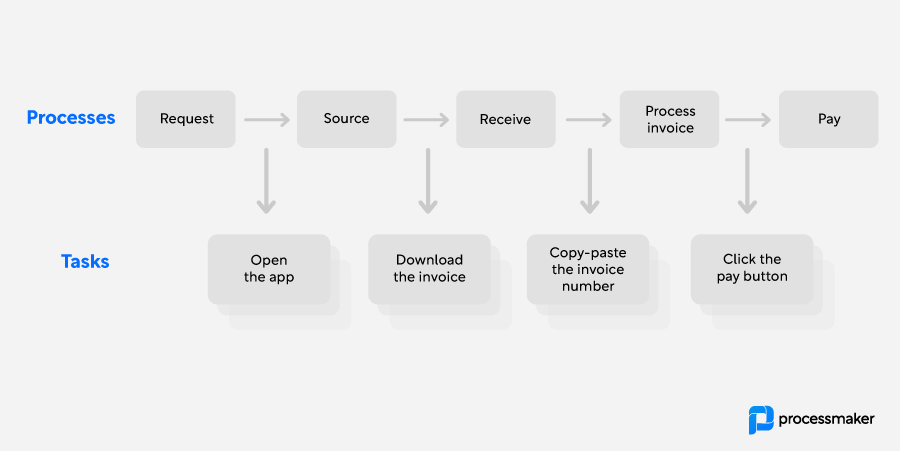
Processes vs tasks
Typical process mining use cases:
Process mining can be used in many different fields for various purposes but here are some of the more popular use cases.
- Auditing & compliance
- Order management
- Purchase-to-pay
- Order-to-cash
- Lead-to-order
- Logistics
Typical task mining use cases:
- Data entries
- Invoicing
- Reporting
- Reconciliation
Differences between process mining, task mining, and process discovery.
Let’s briefly discuss how process mining, process discovery, and task mining differ. Process mining solutions are analytical tools utilized in business process management that leverage system data to provide a comprehensive view of processes. They offer insights into process efficiencies and bottlenecks and can be integrated with task mining for enhanced visibility into both quantitative and qualitative aspects of business processes.
Process mining tools analyze and optimize end-to-end processes, particularly for supply chain management, by collecting event logs from various IT source systems to identify inefficiencies and bottlenecks, providing quantitative insights for process improvement. Task mining, on the other hand, focuses on the granular level of individual tasks within a process.
Origins of data
Process mining leverages system data extracted from event logs across various enterprise information systems like Salesforce, Oracle, and HubSpot. These logs provide crucial information about executed activities, including their IDs and timestamps.
In contrast, process discovery and task mining gather data by monitoring and recording user interactions with computers. This approach captures all processes with the assistance of software agents, ensuring a comprehensive overview of user behavior.
How the data is gathered
The data comes from various sources, necessitating different methods of collection.
For process mining, IT support, and robust back-end development are essential to facilitate integrations with monitored information systems, including enterprise resource planning (ERP) systems.
In the case of process discovery and task mining, software agents need to be installed on users’ computers. These agents operate continuously in the background, capturing everything that occurs within business software and applications.
Completeness of the collected data
It’s important to note that some software and applications do not generate event logs, which significantly limits the potential for process mining. For instance, if the goal is to map the current e-invoicing process and identify areas for improvement, process mining analyzes the distinct steps within the selected e-invoicing platform.
However, if the invoicing expert has to use that platform and some other apps, let’s say Excel, to execute that process, then the steps in Excel get overlooked, thus leaving more space for bad outcomes. So it can only capture the discrete data in the particular steps of the process and leaves the white spaces between logs that are out of the scope of its discovery.
Process discovery and task mining, on the other hand, can gather data from log-producing information systems as well as other productivity applications and software that employees frequently use, such as email and the Microsoft suite. This capability makes them excellent complementary tools for process mining and robotic process automation (RPA), as they can provide valuable insights into shadow activities that might otherwise go unnoticed.
Analysis of the data
Process mining begins with the collection, cleaning, and structuring of data to reconstruct the current state of a process and compare it to the ideal version of that process. By concentrating on key performance indicators (KPIs), this conformance checking employs various data analytics, mining techniques, and data science methods to identify potential bottlenecks and recommend improvements based on observed deviations.
Process discovery captures everything happening on users’ desktops, allowing for an accurate representation of processes as they are executed—complete with all their random deviations and flaws. It visualizes the process as it occurs in real life, creating a metamodel through computer vision, machine learning algorithms, and AI tools. This approach facilitates the identification of root causes and various bottlenecks, making it easier to enhance overall efficiency.
General limitations
Process mining is confined to the steps of specific processes within designated IT systems, neglecting the human element and overlooking users’ digital footprints in other applications, such as personal productivity tools and documents.
While process discovery and task mining introduce a human perspective that process mining may lack, they are most effective for shorter, simpler tasks. Due to the computationally intensive analysis methods employed, longer processes can yield inaccurate results and fail to capture the significance of a task within a broader context.
Common points
Process mining, task mining, and process discovery are valuable tools that have been utilized by companies for several years, yielding impressive results. These methods assist even the largest enterprises in uncovering their automation potential.
Which one is right for you?
The suitability of process mining, task mining, or a combination of both depends on the specific company, use case, and various other factors. Process mining excels at harmonizing distinct processes and aligning them with overarching goals, particularly within large IT systems. It effectively reveals the realities of complex systems such as ERP, CRM, and Supply Chain Management, optimizing the processes contained within them. By harnessing event logs from customer relationship management systems and other enterprise sources, process mining can provide a clear visualization and understanding of business processes.
On the other hand, task mining serves as a valuable alternative when processes span multiple applications, highlighting the significance of minor activities between major steps. It effectively captures human-machine interactions within tasks. Additionally, process discovery is primarily employed to supersede traditional manual discovery techniques, enabling quicker identification of automation opportunities compared to outdated methods.
As we’ve discussed, each option has its flaws that may not suit every company. Some organizations use these approaches together for a more comprehensive analysis of processes. However, they may still fall short of addressing the full range of work-related activities because of the complexities that arise from combining them together.
Where can process intelligence bridge the gap?
ProcessMaker’s process intelligence is a new natively hybrid solution that combines the power of process mining and task mining in one plug-and-play tool. It offers a full-suite solution with everything your enterprise needs to improve its processes and stay ahead of the competition.
